-

Win a Free Custom Engraved Brass Coin!!!
As a way to introduce our brass coins to the community, we will raffle off a free coin during the month of August. Follow link ABOVE for instructions for entering.
-
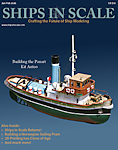
PRE-ORDER SHIPS IN SCALE TODAY!
The beloved Ships in Scale Magazine is back and charting a new course for 2026!
Discover new skills, new techniques, and new inspirations in every issue.
NOTE THAT OUR FIRST ISSUE WILL BE JAN/FEB 2026
You are using an out of date browser. It may not display this or other websites correctly.
You should upgrade or use an alternative browser.
You should upgrade or use an alternative browser.
Grants Xebec 1:60 (using Jabeque Cazador Occre1:60 kit) [COMPLETED BUILD]
- Thread starter GrantTyler
- Start date
- Watchers 85
- Joined
- Dec 16, 2016
- Messages
- 1,137
- Points
- 493

Hi Grant, once again super clean work, it looks greatGreat addition and I love the green tint
Good morning. Thank you. Cheers GrantGreat addition and I love the green tint
What happened to the "BING, BING, BING"? Ricochet Rabbit!! Love the storage chest hinges. Looking snappy as always Grant!
Good morning Ken x 2. Thank you. There is a long way to go before it looks like a decent boat, however slowly getting there. I have been doing research into these boats, previously a shallop and then called a longboat later in the 18th century. I will post a summary of this however what I was amazed at is the size of these....Up to 54ft on the larger vessels and a loaded boat could weigh several tonsHi Grant, once again super clean work, it looks great
- Joined
- Jan 31, 2021
- Messages
- 572
- Points
- 353

Well done!!Ok enough off the topic - back to Grants Xebec: this morning I could fit the bell tower, pumps and main deck cleat I had previously made. The mast is dry fitted as I like to rig as much as possible off the ship. I did add the cleats for the running rigging to mast - 4 of them.
View attachment 408757View attachment 408758View attachment 408756View attachment 408759
Cheers Grant
Well done!!
Good morning. Thank you Mark and Paul. Cheers GrantStunning work Grant, your Xebec is certainly camera-friendly! Very nice indeed
Good morning. A little information on this ships boat. Grants summary : It was commonly used from the 15th to the mid 18th century when it was replaced by the Launch. The longboats were the largest of the ships boat measuring up to 54ft. They were used to transport supplies, arms, men and at times in combat.
Their function was to bring supplies mainly, water and food, which made these very heavy when loaded. (There have been estimates of several tons). The water, in casks or barrels, was stored in the bilges between the thwarts of the long boats.
Due to the size and weight these were towed behind the ships up to the mid 1700’s. Due to many of these being lost at sea especially in inclement weather, it became necessary to store the longboat on the deck. It made for engineering challenges especially with lifting and lowering these heavy loaded boats. A system of block and tackle secured to the fore and mainmast via Burton pendants was used with plenty manpower. These also made the decks especially on the Xebec design crowded and during conflict these were often lowered and towed behind the ship.
The long boat used oars and sails to manoeuvre. Generally a “cutter rig “ (not like the ship) with a gaf design was used for the sails and rigging. It would appear as if the Xebecs used a lanteen sail configuration on the boat as well.
The longboats were often used in battle either on their own or when their parent ship was engaged. In many cases these were armed with swivel canons or special slides for canon to be stowed when not in use.
The longboat of Le Requin is around 36ft and Cazador (well the Occre kit) 33ft.
Some pics :
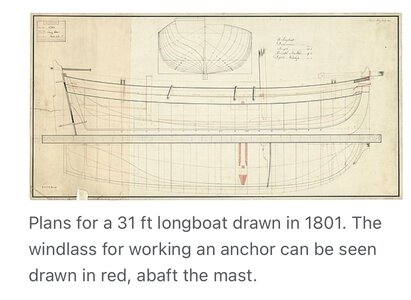

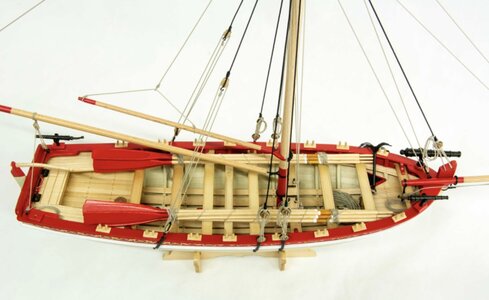

Courtesy of google.
Cheers Grant
Their function was to bring supplies mainly, water and food, which made these very heavy when loaded. (There have been estimates of several tons). The water, in casks or barrels, was stored in the bilges between the thwarts of the long boats.
Due to the size and weight these were towed behind the ships up to the mid 1700’s. Due to many of these being lost at sea especially in inclement weather, it became necessary to store the longboat on the deck. It made for engineering challenges especially with lifting and lowering these heavy loaded boats. A system of block and tackle secured to the fore and mainmast via Burton pendants was used with plenty manpower. These also made the decks especially on the Xebec design crowded and during conflict these were often lowered and towed behind the ship.
The long boat used oars and sails to manoeuvre. Generally a “cutter rig “ (not like the ship) with a gaf design was used for the sails and rigging. It would appear as if the Xebecs used a lanteen sail configuration on the boat as well.
The longboats were often used in battle either on their own or when their parent ship was engaged. In many cases these were armed with swivel canons or special slides for canon to be stowed when not in use.
The longboat of Le Requin is around 36ft and Cazador (well the Occre kit) 33ft.
Some pics :




Courtesy of google.
Cheers Grant
Good morning
Rigging Mizzen mast : Firstly a big thank you for Peters (@Ptèr ) marvellous build log which has helped me understand this unusual rigging. I will mostly copy his interpretation of this ships rigging with one or two deviations along the way. Occre’s plan is too simplified and has been tossed .
.
Grant’s understanding of the Xebec Mizzen rigging.
1. Unlike most square riggers from 1750 the Xebec does not have shrouds, deadeyes etc but a configuration of stays.
2. On the Mizzen there are 2 stays with a block and tackle system to tension these.
3. The stays are secured to the strake on the bulkwark via toggles and the mast via a double rope binding.

Fore stay : There is a double 6mm block from the mast head and a single 6mm attach via the toggle system. I used a 0.8mm rope. The running line is a 0.6mm rope between these blocks
Aft stay : There is a single 6mm block from the mast head and a single 6mm via the toggle system. There is also a 10mm violin block via the middle toggle. The running line runs through these blocks.
I made my own toggles from toothpicks as Occre did not provide enough for a complete rigging rigging process :

The violin blocks where made from a 6mm block and 4mm block:
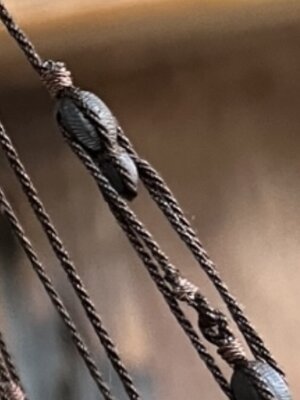
Some pics nothing is tied off:



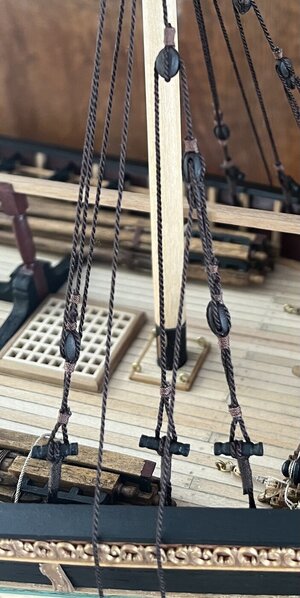
I have chosen to use cotton rope (have to be careful of fluffing) to keep with my objective of this ship being a little “used” and not not too “modelly “ …….I’m not sure I’m getting there but worth the try .
.
Cheers Grant
Rigging Mizzen mast : Firstly a big thank you for Peters (@Ptèr ) marvellous build log which has helped me understand this unusual rigging. I will mostly copy his interpretation of this ships rigging with one or two deviations along the way. Occre’s plan is too simplified and has been tossed
Grant’s understanding of the Xebec Mizzen rigging.
1. Unlike most square riggers from 1750 the Xebec does not have shrouds, deadeyes etc but a configuration of stays.
2. On the Mizzen there are 2 stays with a block and tackle system to tension these.
3. The stays are secured to the strake on the bulkwark via toggles and the mast via a double rope binding.

Fore stay : There is a double 6mm block from the mast head and a single 6mm attach via the toggle system. I used a 0.8mm rope. The running line is a 0.6mm rope between these blocks
Aft stay : There is a single 6mm block from the mast head and a single 6mm via the toggle system. There is also a 10mm violin block via the middle toggle. The running line runs through these blocks.
I made my own toggles from toothpicks as Occre did not provide enough for a complete rigging rigging process :

The violin blocks where made from a 6mm block and 4mm block:

Some pics nothing is tied off:




I have chosen to use cotton rope (have to be careful of fluffing) to keep with my objective of this ship being a little “used” and not not too “modelly “ …….I’m not sure I’m getting there but worth the try
 .
.Cheers Grant
- Joined
- Oct 11, 2021
- Messages
- 739
- Points
- 403

I like that you started with the mizzen mast instead of the fore. The cotton rope looks great. Toggles are nicely done as wel. I don't know about your kit, but mine had some pewter / white metal toggles included that didn't do it for me. I like your's much better!
Keep in mind that the principle of the standing and running rigging stays the same for each mast. Only the Mizzen is a simplified version of the other two with less complexity.
You are doing a great job and fast as well. I'm so curious how she will look with sails.... who is with me?
Keep in mind that the principle of the standing and running rigging stays the same for each mast. Only the Mizzen is a simplified version of the other two with less complexity.
You are doing a great job and fast as well. I'm so curious how she will look with sails.... who is with me?
Very good looking rigging works - the rope looks great
Grant, hi buddy.Good morning
Rigging Mizzen mast : Firstly a big thank you for Peters (@Ptèr ) marvellous build log which has helped me understand this unusual rigging. I will mostly copy his interpretation of this ships rigging with one or two deviations along the way. Occre’s plan is too simplified and has been tossed.
Grant’s understanding of the Xebec Mizzen rigging.
1. Unlike most square riggers from 1750 the Xebec does not have shrouds, deadeyes etc but a configuration of stays.
2. On the Mizzen there are 2 stays with a block and tackle system to tension these.
3. The stays are secured to the strake on the bulkwark via toggles and the mast via a double rope binding.
View attachment 410580
Fore stay : There is a double 6mm block from the mast head and a single 6mm attach via the toggle system. I used a 0.8mm rope. The running line is a 0.6mm rope between these blocks
Aft stay : There is a single 6mm block from the mast head and a single 6mm via the toggle system. There is also a 10mm violin block via the middle toggle. The running line runs through these blocks.
I made my own toggles from toothpicks as Occre did not provide enough for a complete rigging rigging process :
View attachment 410581
The violin blocks where made from a 6mm block and 4mm block:
View attachment 410582
Some pics nothing is tied off:
View attachment 410583View attachment 410584View attachment 410585View attachment 410586
I have chosen to use cotton rope (have to be careful of fluffing) to keep with my objective of this ship being a little “used” and not not too “modelly “ …….I’m not sure I’m getting there but worth the try.
Cheers Grant
Have you done too much in wiring the tackle through the blocks? In my understanding it should be like this

And your running end first goes to the upper block, then to the lower one. As a result, the ropes cross
Wow! That's a lot of progress on the rigging! Impressive as always.
Wow, I don’t understand all the terminology but to my almost “normal again“ vision that rigging looks fantastic.
Jan
Jan
Hi Jan, what Sasha means, is how the violin block tackle is laid (see image below). Both images refer as the Violin tackle, but only the image on the right uses the violin (fiddle) blocks.Wow, I don’t understand all the terminology but to my almost “normal again“ vision that rigging looks fantastic.

Grant,
As always - so impressive!! - PS: also such great blocks.
As always - so impressive!! - PS: also such great blocks.
as Jim showed the correct rope alignment, I would adjust and correct the tackles mentioned by Alexander
Good afternoon Mark. Baai dankie Mnr!!. Cheers GrantThis looks like a plan that is going to come together very well indeed, sterkte Grant
Good afternoon Peter. Thanks. This is why I decided to do the Mizzen first- definitely way less confusing than the other two masts. Again thanks for a brilliant log of your Xebec. I would have been lost without it. Sails…….….…I like that you started with the mizzen mast instead of the fore. The cotton rope looks great. Toggles are nicely done as wel. I don't know about your kit, but mine had some pewter / white metal toggles included that didn't do it for me. I like your's much better!
Keep in mind that the principle of the standing and running rigging stays the same for each mast. Only the Mizzen is a simplified version of the other two with less complexity.
You are doing a great job and fast as well. I'm so curious how she will look with sails.... who is with me?
 . I will give it a go…
. I will give it a go…
